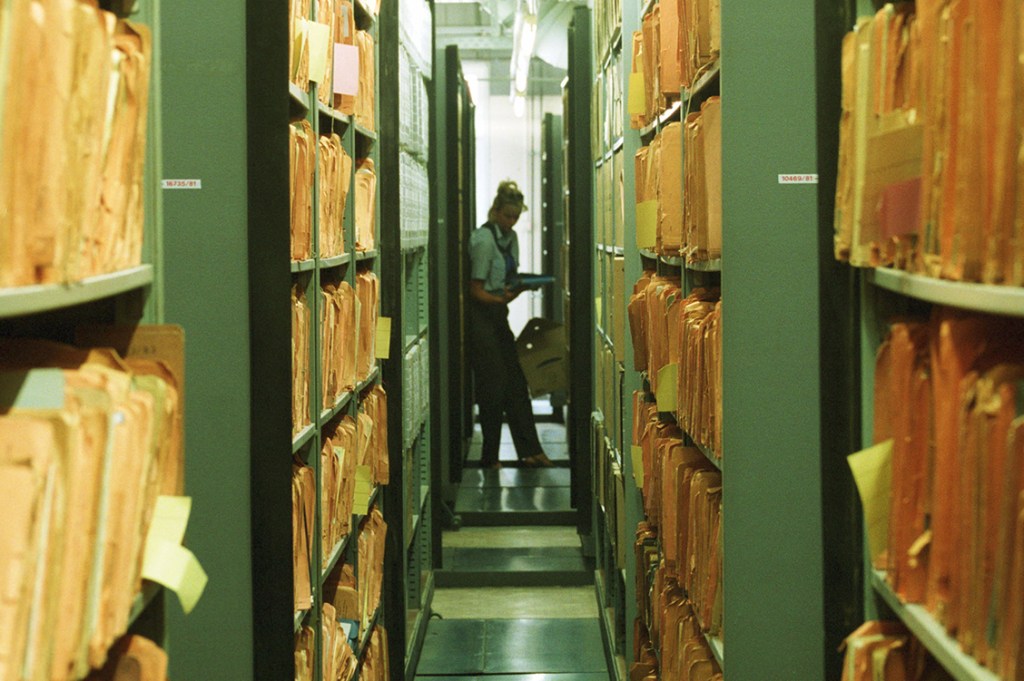‘Oh please…not the letters I sent to my mom,’ sighed the East German pastor Gernot Friedrich as he randomly pulled pages out of the 3,000-page file. Since January 1992, Germany has attempted a unique experiment in addressing its own past: anyone can request to view their Stasi file.
Founded in 1950 as the Socialist party’s ‘sword and shield’, the Ministry for State Security, better known as the Stasi, spent its 40-year existence gathering information about real and imagined political opponents. It created one of the most comprehensive police states in the world, dwarfing even the Nazi’s infamous Gestapo. Where the latter operated at around one officer to 10,000 citizens, at its peak the Stasi had one officer to every 180 East Germans.
The scale of the GDR’s surveillance took on such proportions that the Stasi began to recruit hundreds of thousands of ‘unofficial’ employees, casual informants who could provide information about individuals or entire communities. Such collaborators could be work colleagues, neighbors or friends and their motivations ranged from monetary incentives to personal vendetta. Many felt safe in the knowledge that their Stasi activities would remain forever concealed.
But the fall of the Berlin Wall changed that. In total, over 2.2 million people have requested access to the five million files. Like Gernot Friedrich, they often found their discoveries disturbing. His vast file contained a detailed plan of his flat and remarks made by a fellow pastor who had been pressed by the Stasi to collaborate.
‘When I read this, it sounds as if they were talking about somebody else,’ said the baffled Friedrich, echoing the thoughts of so many reading back how others described their own lives. What crimes had made him so infamous that the Stasi felt the need to keep such a close eye on him? He loved to travel and he loved danger and adventure. Friedrich kept visiting the USSR illegally, smuggling Bibles into Russia and Eastern Bloc countries. ‘The Soviets feared bibles as if they were bombs,’ he said with a satisfied smile, flicking through the copious notes detailing his activities.
After an initial frenzy in the early 1990s, requests made to the Stasi Records Agency have slowed down but there are still as many as 4,500 a month. Yet, the agency was shut down on Thursday, 68 years after Russian tanks put down a mass East German revolt. The set-up was only ever intended to be temporary. As the documents slowly begin to wither into historical evidence, it seems right that the files are transferred into Germany’s Federal Archives.
In the months following the collapse of the GDR, quick access to the files was deemed more important than systematic archiving. Thus 16,000 sacks of documents stayed where they were in Magdeburg and Berlin which meant that historians struggled to make sense of the material or find specific items. The Federal Archive will begin the long and arduous task of cataloging, digitizing and preserving these important documents for the future.
This was always going to be a painful process for those who suffered at the hands of the GDR authorities. The Stasi Records Agency shone a light on these dark chapters of German history. It provided transparency and for some even an opportunity to mount legal challenges and claim compensation for the injustices inflicted upon them.
While former East Germans will continue to be able to request access to the files, the headquarters of the Federal Archives in Koblenz seem a long way away. The right-wing AfD party, which is particularly popular in the former East, has tried to make political headway by claiming that the files will now be hidden away to shield the former ‘wall shooters’ — an allusion to the fact that some former GDR politicians have found a new home in the far-left party Die Linke. The argument that only 2 percent of the files are so far digitalized, something that the Federal Archives could speed up, is unlikely to cool the heated debate around the legacy of East Germany’s police state.
The head of the now-defunct Stasi Records Agency, Roland Jahn, told Spiegel magazine that the dissolution of his department was not a move to hide away from uncomfortable truths — quite the contrary. Where the focus in the 1990s was naturally on those directly affected, thirty years on Germans are beginning to think about future generations. Access to the files will need to be less personal, less ad hoc and more systematic if historians are to make sense of the bigger picture. There are fewer Gernot Friedrichs browsing through their own postcards. But private individuals will still be able to access their own files or those of close relatives.
Historians like me are happy to see Stasi files moved from their temporary department to a more permanent and professionally managed home in the Federal Archives. It is a rational way to transition painful memories into the annals of history. Germany is unique among Western nations in that it has to juggle the histories and legacies of two states within the framework of one collective narrative. The dissolution of the Stasi Records Agency is part of that painful struggle for Germany to come to terms with itself.
This article was originally published on The Spectator’s UK website.

























